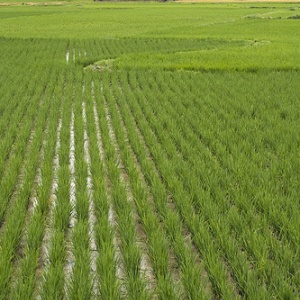
A new genetic variety of rice has properties that ensure that the methane emissions that are normally released in production are substantially reduced. Biochemists in Sweden, China and the United States have worked together to create a new rice variety called SUSIBA2, which has now been dubbed the world’s first ‘climate-friendly rice’.
The rice nearly eliminates the production of the greenhouse gas methane and the research has now been named the grand prize winner for engineering in the American magazine Popular Science’s annual Best Tech of the Year edition. The paper presenting the new variety was published in 2015, but we include it here as it may interest many Fodder subscribers.
Abstract
Atmospheric methane is the second most important greenhouse gas after carbon dioxide, and is responsible for about 20% of the global warming effect since pre-industrial times. Rice paddies are the largest anthropogenic methane source and produce 7–17% of atmospheric methane. Warm waterlogged soil and exuded nutrients from rice roots provide ideal conditions for methanogenesis in paddies with annual methane emissions of 25–100-million tonnes. This scenario will be exacerbated by an expansion in rice cultivation needed to meet the escalating demand for food in the coming decades. There is an urgent need to establish sustainable technologies for increasing rice production while reducing methane fluxes from rice paddies. However, ongoing efforts for methane mitigation in rice paddies are mainly based on farming practices and measures that are difficult to implement. Despite proposed strategies to increase rice productivity and reduce methane emissions, no high-starch low-methane-emission rice has been developed. Here we show that the addition of a single transcription factor gene, barley SUSIBA2, conferred a shift of carbon flux to SUSIBA2 rice, favouring the allocation of photosynthates to aboveground biomass over allocation to roots. The altered allocation resulted in an increased biomass and starch content in the seeds and stems, and suppressed methanogenesis, possibly through a reduction in root exudates. Three-year field trials in China demonstrated that the cultivation of SUSIBA2 rice was associated with a significant reduction in methane emissions and a decrease in rhizospheric methanogen levels. SUSIBA2 rice offers a sustainable means of providing increased starch content for food production while reducing greenhouse gas emissions from rice cultivation. Approaches to increase rice productivity and reduce methane emissions as seen in SUSIBA2 rice may be particularly beneficial in a future climate with rising temperatures resulting in increased methane emissions from paddies.
Citation
J. Su, C. Hu, X. Yan,Y. Jin, Z. Chen, Q. Guan, Y. Wang, D. Zhong, C. Jansson, F. Wang, A. Schnürer & C. Sun. (2015) Expression of barley SUSIBA2 transcription factor yields high-starch low-methane rice. Nature 523, 602–606 doi:10.1038/nature14673.
Read the full paper here and see an article in Science about the research here. There is further and more recent coverage from the lead researcher’s University SLU here.
You can find related resources in the Research Library categories on Primary production: agriculture and keywords Climate change mitigation, methane, rice, and biotechnology.







Post a new comment »